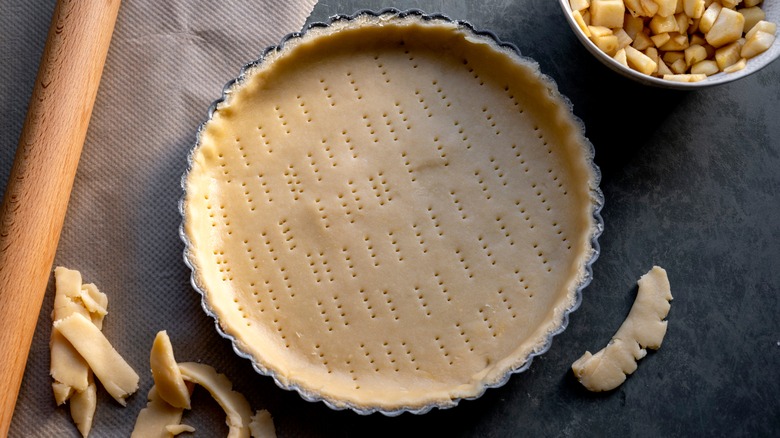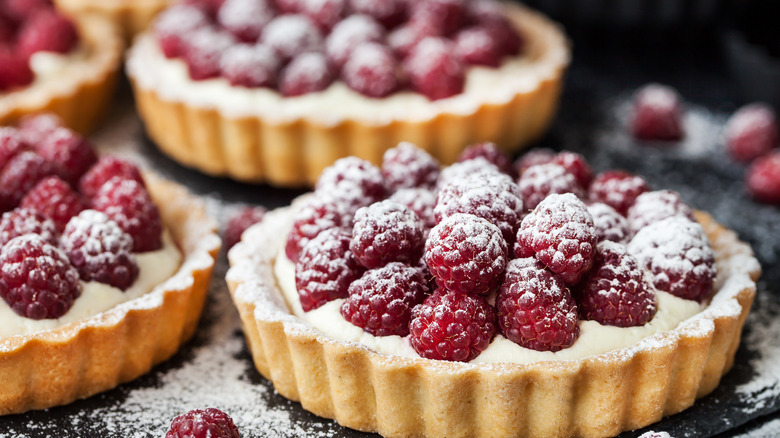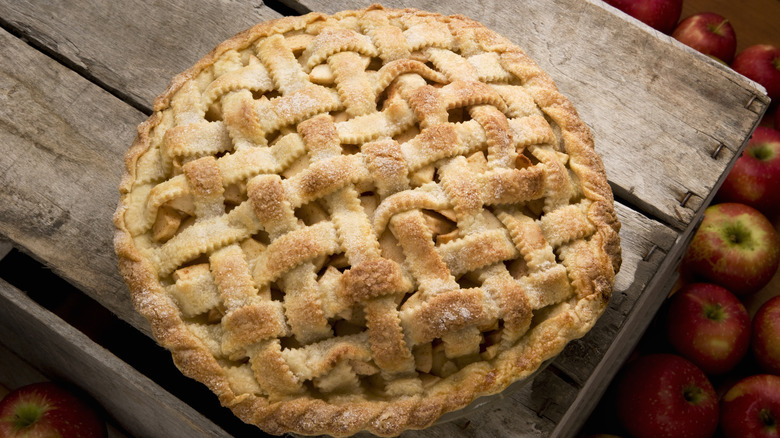The Key Difference Between Pies And Tarts
Pies and tarts are almost like minivans and convertibles. Though both have the same basic function (transporting the precious cargo inside them), the former is seen as more functional and durable while the latter features an open top and a fancier look. Neither is better; they just meet different needs and appeal on different occasions.
Similes aside, the difference between pies and tarts comes down to their crusts. Pies feature a fat and flour base, and they often have a top and bottom (or one or the other). Tarts, on the other hand, use shortcrust pastry as their base. There are multiple iterations of this type of dough, but they all contain more flour than a classic pie crust and are known for their crumblier texture.
The crusts also behave differently in the oven. Pie crusts shrink slightly when they bake, and they're cooked in a pie dish. Tarts hold their shape as they bake. The pretty dessert also has its own special tins with lower sides, fluted edges, and removable bottoms that are taken off before serving. You can prepare both treats with savory or sweet fillings, but, unlike with pies, tarts will always have an open face.
All about tart crusts
We usually think of a pie crust as a neutral, flaky vessel for filling. Tarts are less constrained. Chefs have come up with three versions of the pastry, which range in sweetness and texture. As such, hosts can pair a buttery shell with vegetable fillings for brunch. Come dessert, they can serve a chocolate tart — maybe one that takes inspiration from Giada De Laurentiis and is topped with pop rocks — inside a sweet pastry.
The classic tart doughs are called pâte brisée, pâte sucrée, and pâte sablée. The first, pâte brisée, is closest to an American pie crust and, in fact, sometimes used to make the stateside dessert. It's made of butter, flour, sugar, salt, and water, but the ingredients are mixed together more than in the American crust. As a result, the European version is stronger but less flaky. Not very sweet, pâte brisée is often utilized in savory dishes.
Pâte sucrée and pâte sablée, on the other hand, bear a closer resemblance to cookies. Both are enriched with eggs and contain sugar, but sucrée dough requires dry ingredients to be mixed before the butter is added. Pâte sablée's preparation stands apart. It features softened butter that's creamed with the sugar and almond flour, yielding a sandy rather than flaky texture. Both options are ideal for rich fillings ranging from fruit and custard to chocolate and nuts.
Baking a better pie
In the U.S., pies often overshadow tarts. The patriotic dessert hosts a multitude of fillings and always has a spot at summer and fall celebrations. But a tart has its own charms and strengths. Perhaps it's time for bakers to meet in the middle and apply some tart tactics to their pies.
One rule of tart making is that, regardless of dough type, the shell gets blind-baked before use to ensure a crispy bottom. Blind baking is when an empty crust gets a 15-20 minute bake while held in shape by ceramic weights or even beans. We're guilty of skipping this step at times when it comes to pies, but it's worth making the effort to combat soggy, quick-cooking fillings. This technique is especially handy for liquid or custard fillings, like with Thanksgiving favorites like pecan and pumpkin pie.
For an even richer, French-inspired crust, look no further than pie maven Martha Stewart for a butter tip. She suggests using high-quality, European-style dairy, which contains more fat, in her dough. Though you're likely not going to sweeten the pastry into a pâte sucrée, you can take inspiration by elevating the usual egg wash with a dusting of sugar to create a crunchy exterior.



